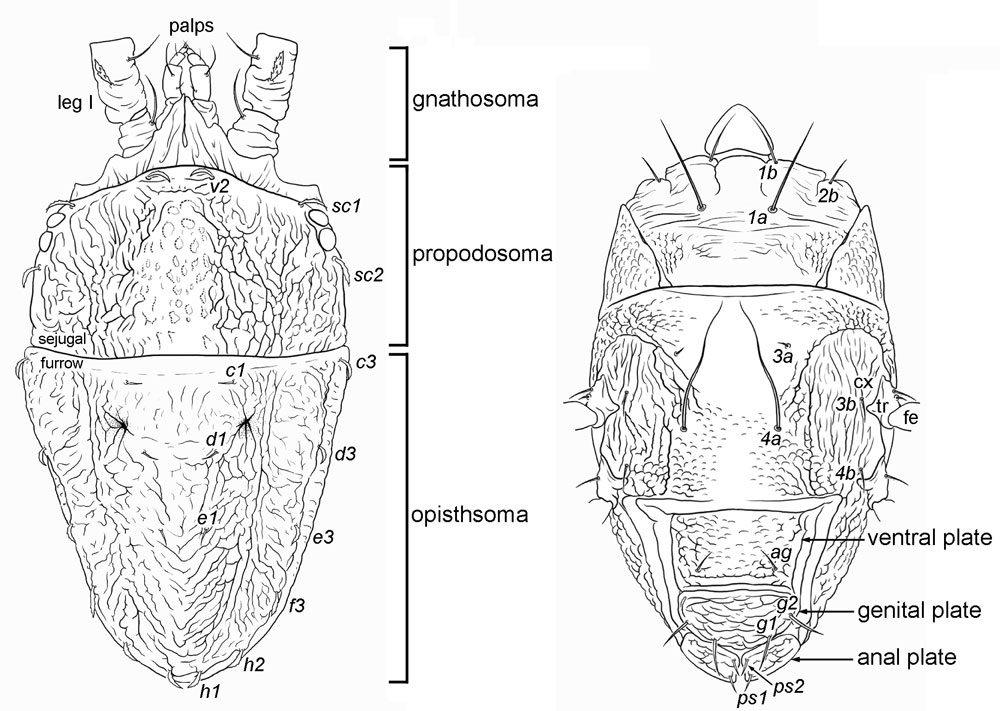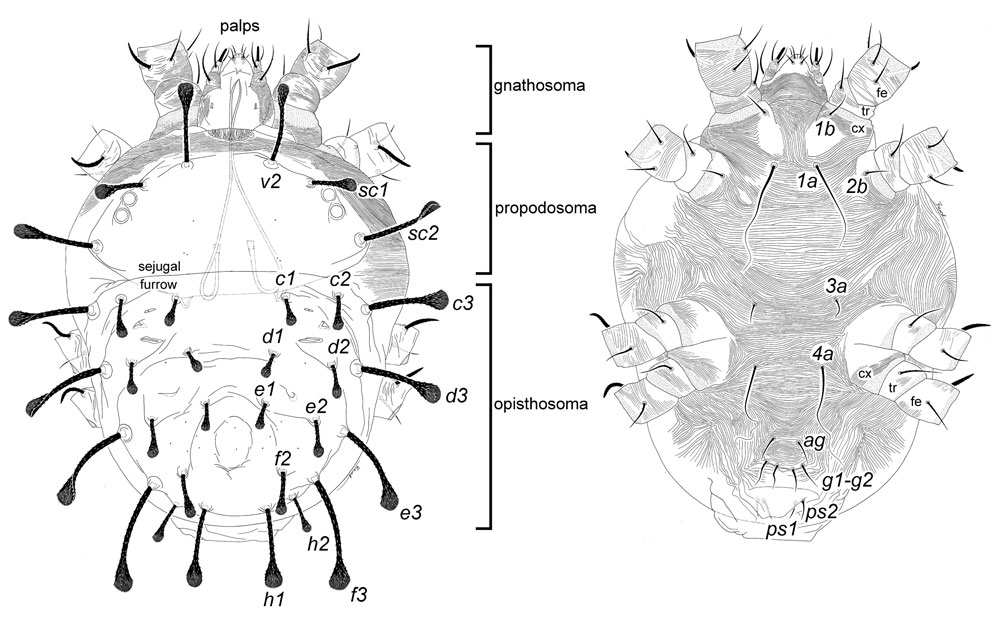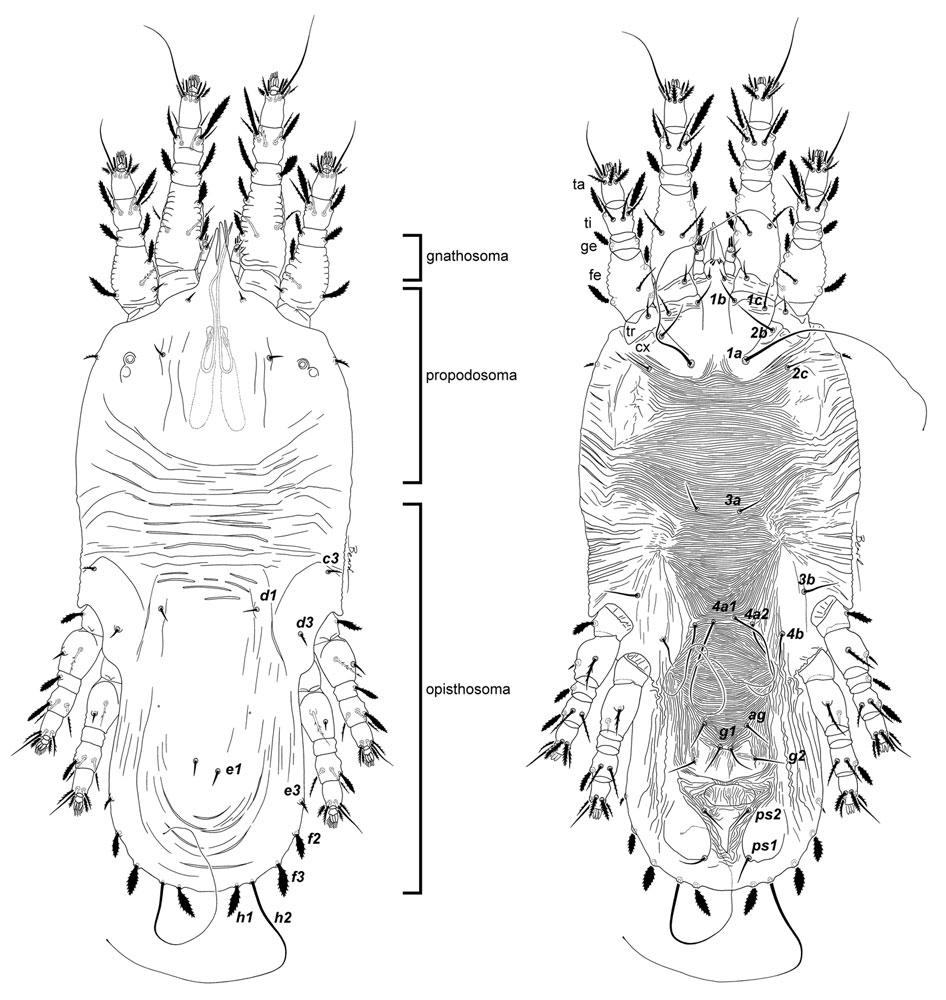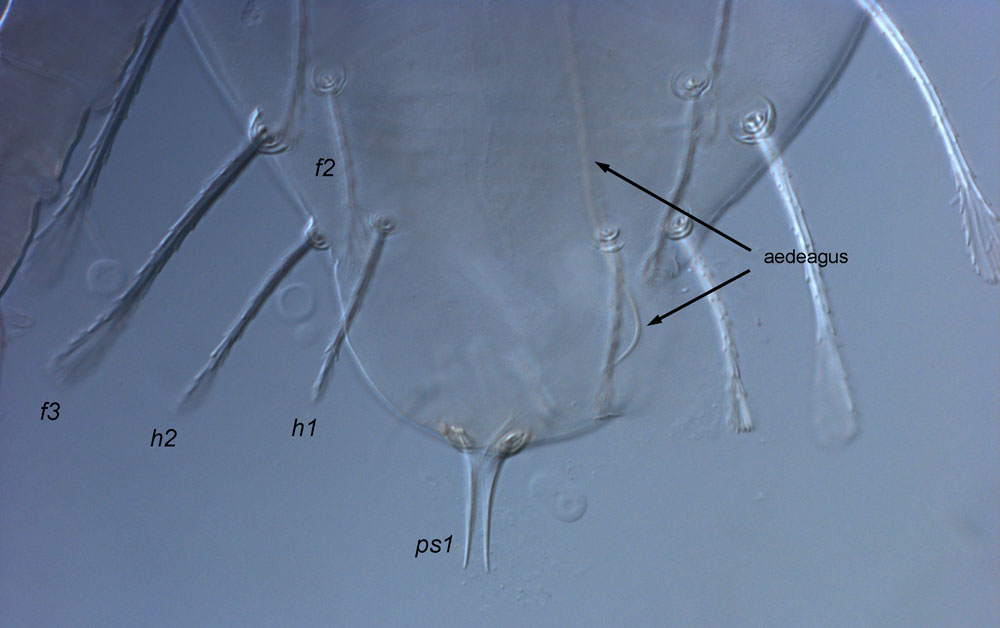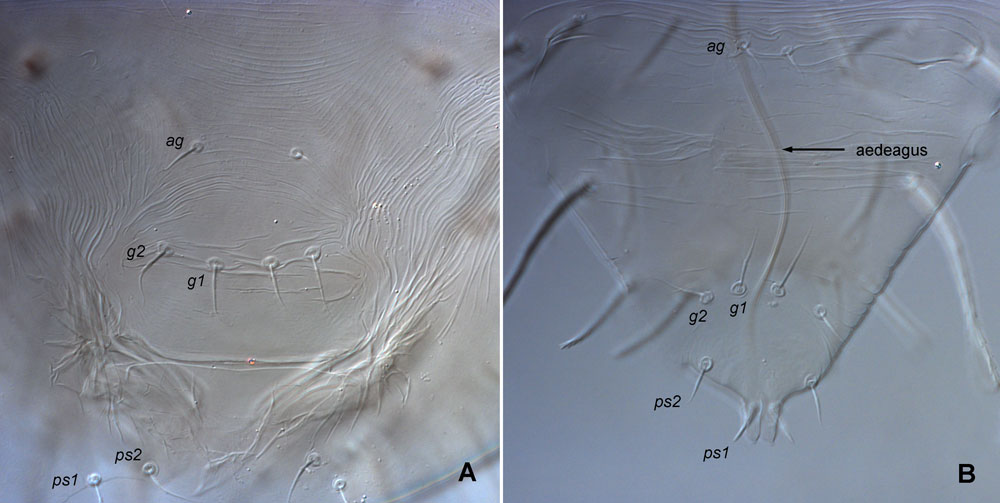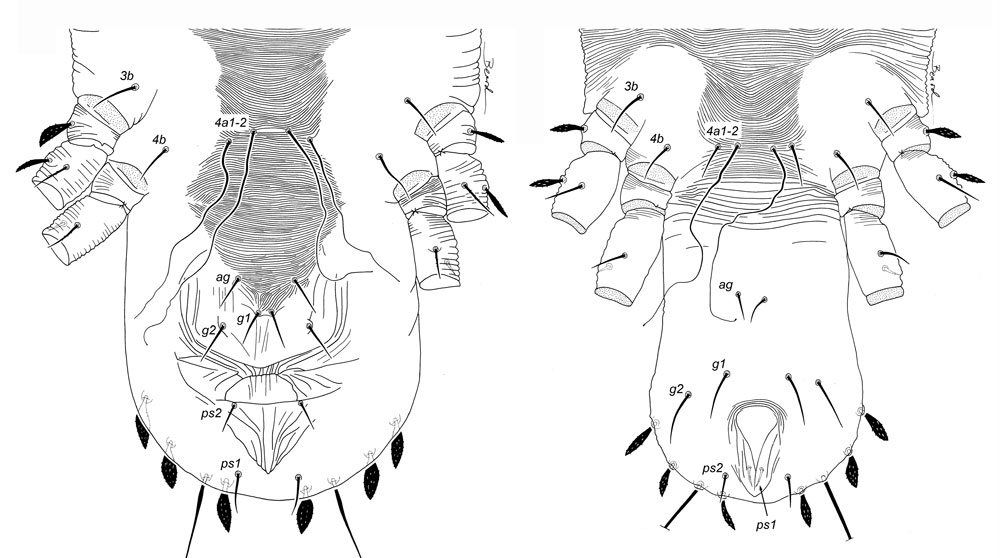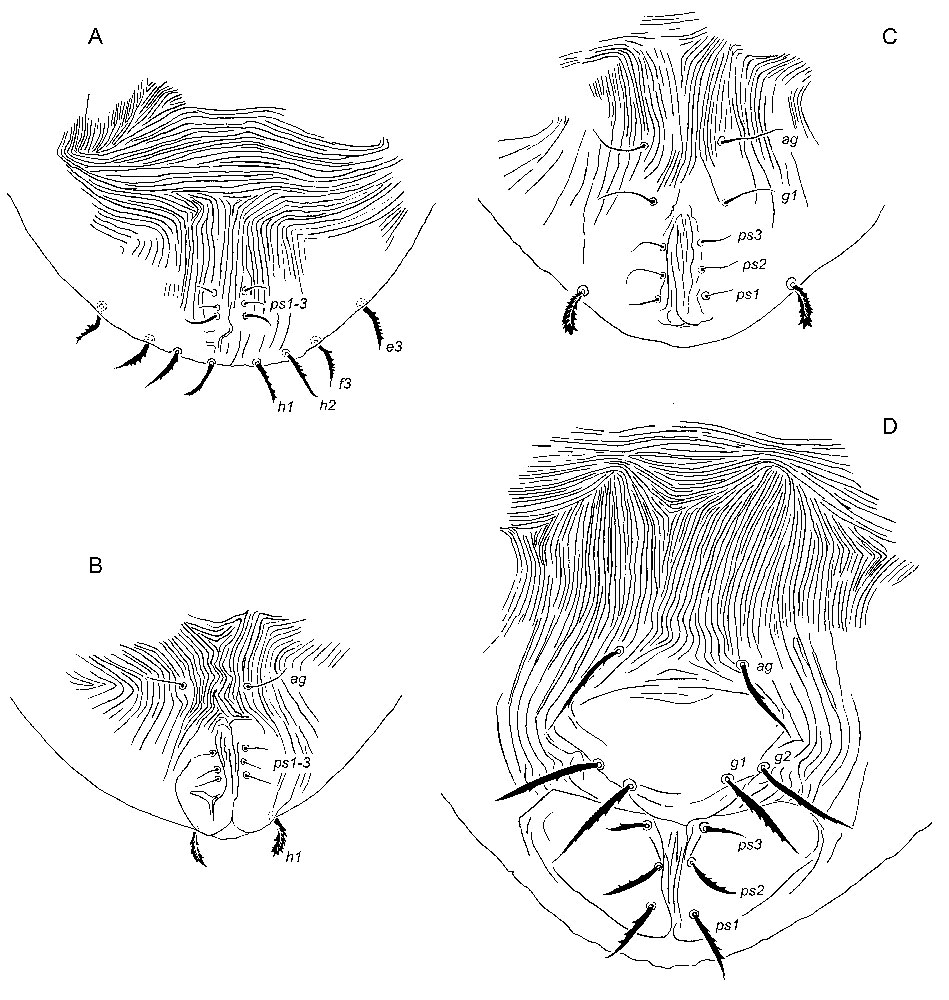About flat mites
Flat mite morphology and sex/stage determination
The morphological characters use to identify the different genera and species in the family Tenuipalpidae are based on the adult female and include the number of setae on the body, the shape and type of setae, the genital region, the number of palpal segments and their setation, the number and position of setae on the legs, the number of solenidia on legs I and II, the sculpturing on the dorsal and ventral cuticle/integument, and presence/absence of claws on the pretarsus. Host plant associations can occasionally prove helpful when identifying genera due to some specificity within the family.
There are many ways to divide the body of a flat mite into separate parts. For ease with use of the key, there are 3 general body parts of significance: (i) gnathosoma, the anterior portion of the body between legs I which includes the palps/mouthparts; (ii) propodosoma (including prodorsum), the anterior portion of the body; and (iii) opisthosoma, the dorsal opisthosoma is everything posterior to the sejugal furrow (main fold in the body between legs II and III), and the ventral opisthosoma is everything posterior to legs IV (includes ventral, genital and anal plates) (Figs 7, 8, 9).
Naming setae on the dorsal opisthosoma (figs 7-9)
The opisthosoma of tenuipalpids bears between 5 and 13 pairs of setae, located in 5 transverse rows, C, D, E, F, H, from the anterior to posterior respectively. The central most setae in each row are labelled as “1” and the most lateral setae are labeled as “3”. Rows C, D, E can have up to 3 pairs present (i.e. c1, c2, c3, d1, d2, d3 etc), but setal rows F and H have a maximum of only 2 pairs present (f2, f3; h1, h2).
Some setae in the flat mite family are stable, i.e. they are present in nearly all tenuipalpid species - sc1, sc2, c3, d3, e3, h1, and h2. To name a seta, it will help if you start by naming each row starting at row C, and then locate each seta in the row.
-
Figure 7: general Brevipalpus body plan -
Figure 8: general Raoiella body plan -
Figure 9: general Acaricis body plan
Naming setae on the venter (figs 7-9)
The ventral setae have seldom been used in the classification of tenuipalpid genera and species, but they are used here at a specific level (e.g. Raoiella key).
Normally, there are up to 15 pairs of setae present on the venter (1a, 1b, 1c, 2b, 2c, 3a, 3b, 4a, 4b, ag, g1, g2, ps1, ps2, ps3). Abnormally, some of these setae are secondarily multiplied and may confuse things (e.g. 4a is doubled in genus Acaricis, Fig. 9). Setae 1a are located between the bases of coxae I (basal segment of leg I). Setae 1b and 1c are located anterior to 1a on coxa I. Setae 2b and 2c are located on coxae II. Setae 3a and 4a are usually located along the midline of the body between the bases of coxae III and IV, respectively. Setae 3b and 4b are located on coxae III and IV, respectively.
The posterior venter is an important region taxonomically as it includes the genital and anal regions. There is one pair of aggenital setae (ag) located posterior to setae 4a, but anterior to the genital region. The genital setae (normally 2 pairs - g1, g2) are located on the genital plate/flap. The pseudanal setae (1-3 pairs - ps1, ps2, ps3) are located around the anus, sometimes on distinct anal plates.
What stage do I have?
Flat mites, like all their other relatives in the superfamily Tetranychoidea, do not add any setae to the dorsum during development from the larva to the adult. So the best way to tell the sex or stage of your mite is by looking at the venter, in particular the posterior venter of your specimen, from leg IV to the posterior margin. Each stage and sex of flat mite has its setae arranged into a characteristic pattern. Females and males have the same number of setae, though each has a distinct pattern, and immature stages have less setae in this region than the adults.
Female flat mites (Figs 7-9, 15d) generally always have seta 4a present between legs IV; seta 4b when present is located on coxa IV; seta ag is located between 4a and g1-g2, just anterior to the genital plate; setae g1 and g2 are located on a variously developed genital plate; setae ps1 and ps2 or ps1-3 are located on the anal plates, between the genital plate and the posterior margin of the body.
-
Figure 10: male Raoiella with aedeagus -
Figure 11: female (a) and male (b) Raoiella posterior venter -
Figure 12: female (a) and male (b) Acaricis posterior venter -
Figure 13: female (a) and male (b) Tenuipalpus posterior venter -
Figure 14: male Brevipalpus with 2 opisthomal shields
Male flat mites have an aedeagus (Figs 10, 11b) and do not have a genital plate. As a result, the setae in this region are arranged in different patterns than the female. Setae 4a and 4b are in the same location, and setae ag, g1-2, ps1-3 can be in a fairly similar position to that of the female (Figs 11b, 12b) or can be quite tightly aligned together posteriorly around the genital-anal region (Fig. 13b). The males of many genera have modified ps1 setae (presumably used in mating). The modified ps1 setae tend to be much thicker and sometimes longer than the other ps setae (Figs 10, 11b-13b). Males have a few additional morphological features that can be used to separate them from females, including a distinct band of transverse striae on venter usually present between legs IV (Fig. 12b); often with 2 opisthosomal shields (Fig. 14); often with two solenidia on tarsus I and sometimes with a solenidion on tarsi III-IV.
-
Figure 15: immature posterior venters of larva (a), protonymph (b), deutonymph (c), and female (d) -
Figure 16: immature posterior venters of larva (a), protonymph (b), and female (c) and male deutonymph (d)
Immature stages of flat mites lack fully developed genitalia, though the associated setae are added during the development from the larval stage to the adult. The larva is easily recognized as it has only 3 pairs of legs and very few ventral setae present, with only the full complement of ps setae present on the posterior venter (Figs 15a, 16a). Some posterior dorsal setae are often inserted ventrally on the larva and protonymph, and can cause some confusion when naming setae (Figs 16a, b).
The protonymph adds the ag seta to the posterior venter (Figs 15b, 16b). The deutonymph adds setae 4a, 4b and g1 to the posterior venter (Figs 15c, 16c, d). Often female deutonymphs (Fig. 16c) can be distinguished from male deutonymphs (Fig. 16d) based on slight morphological differences.

